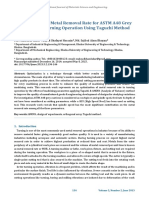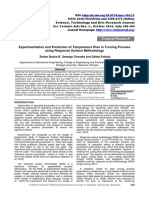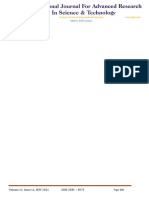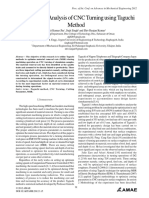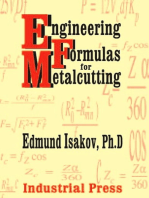0 ratings0% found this document useful (0 votes)
16 viewsFile-1
File-1
Uploaded by
Deepak KumarThe document discusses factors that influence the metal cutting process like tool material, workpiece material, and cutting parameters. It then provides an overview of the Taguchi method, including its eight steps. The document notes how the Taguchi method uses orthogonal arrays to investigate parameters using few tests, saving time and costs. It applies this to analyzing experimental parameters in optimizing cutting forces. Finally, it briefly discusses some limitations of the Taguchi method.
Copyright:
© All Rights Reserved
Available Formats
Download as PPTX, PDF, TXT or read online from Scribd
File-1
File-1
Uploaded by
Deepak Kumar0 ratings0% found this document useful (0 votes)
16 views9 pagesThe document discusses factors that influence the metal cutting process like tool material, workpiece material, and cutting parameters. It then provides an overview of the Taguchi method, including its eight steps. The document notes how the Taguchi method uses orthogonal arrays to investigate parameters using few tests, saving time and costs. It applies this to analyzing experimental parameters in optimizing cutting forces. Finally, it briefly discusses some limitations of the Taguchi method.
Original Title
ppt file-1
Copyright
© © All Rights Reserved
Available Formats
PPTX, PDF, TXT or read online from Scribd
Share this document
Did you find this document useful?
Is this content inappropriate?
The document discusses factors that influence the metal cutting process like tool material, workpiece material, and cutting parameters. It then provides an overview of the Taguchi method, including its eight steps. The document notes how the Taguchi method uses orthogonal arrays to investigate parameters using few tests, saving time and costs. It applies this to analyzing experimental parameters in optimizing cutting forces. Finally, it briefly discusses some limitations of the Taguchi method.
Copyright:
© All Rights Reserved
Available Formats
Download as PPTX, PDF, TXT or read online from Scribd
Download as pptx, pdf, or txt
0 ratings0% found this document useful (0 votes)
16 views9 pagesFile-1
File-1
Uploaded by
Deepak KumarThe document discusses factors that influence the metal cutting process like tool material, workpiece material, and cutting parameters. It then provides an overview of the Taguchi method, including its eight steps. The document notes how the Taguchi method uses orthogonal arrays to investigate parameters using few tests, saving time and costs. It applies this to analyzing experimental parameters in optimizing cutting forces. Finally, it briefly discusses some limitations of the Taguchi method.
Copyright:
© All Rights Reserved
Available Formats
Download as PPTX, PDF, TXT or read online from Scribd
Download as pptx, pdf, or txt
You are on page 1of 9
Optimization of cutting force via variable feed rate in AISI 304
stainless steel with cemented carbide insert cutting tool using in
dry turning lathe Taguchi and ANOVA Methodology
Animesh Mondal (12000720052)
Animesh Kumar (12000720045)
Guided by
DEEPAK KUMAR
ASST.PROFESSOR
Department of Mechanical Engineering
DR.B.C.ROY ENGINEERING COLLEGE
Metal cutting principle
Introduction
Mechanics of metal cutting consists of study of
machining process and accurate estimation of
dynamic cutting forces by the use of suitable
analytical models. Different scientists have
prepared different models and advanced their own
theory and analysis of metal cutting action. There
are certain basic concepts used by most of them. A
wedge-shaped tool with a straight cutting edge is
made to move relative to the work piece and a
layer of metal called chip is removed.
Factors Influencing Metal Cutting Process Various factors or
parameters that affects the cutting process and so surface finish and
accuracy of part geometry.
Independent variables
The major independent variables are:
• Cutting tool material, shape, geometry, angles.
• Work piece material, condition, temperature
• Cutting parameters, such as speed, feed, and depth of cut.
• Cutting fluids.
• Machine tool specifications
Dependent variable
Dependent variables are influenced by changes in independent variables. The
major dependent variables are:
• Types of chips formed
• Temperature zone at work tool interface
• Tool wear and failures.
• Surface finish.
• Force and energy in cutting process
Taguchi method
Taguchi's techniques have been used widely in engineering design (Ross 1996 & Phadke 1989). The
Taguchi method contains system design, parameter design, and tolerance design procedures to
achieve a robust process and result for the best product quality (Taguchi 1987 & 1993). The main
trust
of Taguchi's techniques is the use of parameter design (Ealey Lance A.1994), which is an engineering
method for product or process design that focuses on determining the parameter (factor) settings
producing the best levels of a quality characteristic (performance measure) with minimum variation.
Taguchi designs provide a powerful and efficient method for designing processes that operate
consistently and optimally over a variety of conditions. To determine the best design, it requires the
use of a strategically designed experiment, which exposes the process to various levels of design
parameters.
Eight-Steps in Taguchi Methodology:
• Step-1: Identify the main function, side effects, and failure mode
• Step-2: Identify the noise factors, testing conditions, and quality
characteristics
• Step-3: Identify the objective function to be optimized
• Step-4: Identify the control factors and their levels
• Step-5: Select the orthogonal array matrix experiment
• Step-6: Conduct the matrix experiment
• Step-7: Analyze the data, predict the optimum levels and performance
• Step-8: Perform the verification experiment and plan the future action
Application
• Taguchi method uses a specific orthogonal array to resolve this problem and
investigate all parameters by using a few tests (simulations).
• Taguchi method is widely used in engineering analysis with the aim of
obtaining information about the behavior of a process
• The biggest advantages of this method include saving the number of
experiments (simulations), saving the time, reducing the costs, etc
• The Taguchi method is used for evaluating the results of matrix experiments to
determine the best levels of experimental parameters.
• It makes it possible to provide an acceptable formulation using minimum raw
materials and time
• The signal-to-noise (S/N) ratio and the analysis of variance (ANOVA) were
employed to analyze the experimental parameters.
Limitations
• Results obtained are only relative and do not exactly indicate
what parameter has the highest effect on the performance
characteristic value
• Also, since orthogonal arrays do not test all variable
combinations, this method should not be used with all
relationships between all variables are needed.
• The Taguchi method has been criticized in the literature for
difficulty in accounting for interactions between parameters.
Thank you
You might also like
- IJMSEDocument13 pagesIJMSEShafayat HossainNo ratings yet
- Taguchi MethodDocument8 pagesTaguchi MethodLSARAVANAN91No ratings yet
- Application of Taguchi Method For Optimizing Turning Process by The Effects of Machining ParametersDocument12 pagesApplication of Taguchi Method For Optimizing Turning Process by The Effects of Machining ParameterscevherimNo ratings yet
- Optimizing Surface RoughnessDocument7 pagesOptimizing Surface Roughnesskarpaga raj aNo ratings yet
- Optimization of Cutting Parameters in Hard Turning of AISI 4340 SteelDocument6 pagesOptimization of Cutting Parameters in Hard Turning of AISI 4340 SteelIJIRAE- International Journal of Innovative Research in Advanced EngineeringNo ratings yet
- Lean Thi Nki NGDocument17 pagesLean Thi Nki NGcevherimNo ratings yet
- Optimization of Cutting Parameters in High Speed Turning by Grey Relational AnalysisDocument8 pagesOptimization of Cutting Parameters in High Speed Turning by Grey Relational AnalysiscevherimNo ratings yet
- Finite Element Analysis of Cutting Forces in High Speed MachiningDocument8 pagesFinite Element Analysis of Cutting Forces in High Speed MachiningShruthi N. KumarNo ratings yet
- Received On: 08-03-2014 Accepted On: 12-03-2014 Published On: 15-03-2014 Taquiuddin Quazi, Pratik Gajanan MoreDocument20 pagesReceived On: 08-03-2014 Accepted On: 12-03-2014 Published On: 15-03-2014 Taquiuddin Quazi, Pratik Gajanan MoreAlexandrina BugaNo ratings yet
- International Journal of Industrial Engineering ComputationsDocument12 pagesInternational Journal of Industrial Engineering ComputationsKabil RajNo ratings yet
- 152 S 851 PDFDocument7 pages152 S 851 PDFDarling RajNo ratings yet
- Blow Hole Defect Analysis in Die CastingDocument37 pagesBlow Hole Defect Analysis in Die CastingSumeet RatheeNo ratings yet
- 06 2009 041 Motorcu 391 401 3k 4kDocument11 pages06 2009 041 Motorcu 391 401 3k 4kGus DurNo ratings yet
- A Review of Optimization Techniques in Metal Cutting ProcessesDocument21 pagesA Review of Optimization Techniques in Metal Cutting Processesnavabnavab786No ratings yet
- Optimization of Cutting Parameters in Turning Operation of Mild SteelDocument6 pagesOptimization of Cutting Parameters in Turning Operation of Mild SteelIzzah HzmhNo ratings yet
- Welcome To International Journal of Engineering Research and Development (IJERD)Document7 pagesWelcome To International Journal of Engineering Research and Development (IJERD)IJERDNo ratings yet
- Application of Integrated Taguchi and TOPSIS Method For Optimization of Process Parameters For Dimensional Accuracy in Turning of EN25 SteelDocument9 pagesApplication of Integrated Taguchi and TOPSIS Method For Optimization of Process Parameters For Dimensional Accuracy in Turning of EN25 SteelKenan MuhamedagicNo ratings yet
- A Study of The Effects of Machining Parameters On The Surface Roughness in The End-Milling ProcessDocument7 pagesA Study of The Effects of Machining Parameters On The Surface Roughness in The End-Milling ProcessDesalegn DgaNo ratings yet
- Optimization of Machining Parameters of 20MnCr5 Steel in Turning Operation Using Taguchi TechniqueDocument11 pagesOptimization of Machining Parameters of 20MnCr5 Steel in Turning Operation Using Taguchi TechniqueIJMERNo ratings yet
- A Review On Optimization of Process Parameters in Turning Operation Carried Out by Coated InsertDocument6 pagesA Review On Optimization of Process Parameters in Turning Operation Carried Out by Coated InsertKalai ArasanNo ratings yet
- Insert Selection For Turning Operation On CNC Turning Centre Using MADM MethodsDocument11 pagesInsert Selection For Turning Operation On CNC Turning Centre Using MADM Methodsprince duhanNo ratings yet
- Original ResearchDocument6 pagesOriginal ResearchbalajimetturNo ratings yet
- Multi-Response Optimization by Experimental Investigation of Machining Parameters in CNC Turning by Taguchi Based Grey Relational AnalysisDocument9 pagesMulti-Response Optimization by Experimental Investigation of Machining Parameters in CNC Turning by Taguchi Based Grey Relational Analysissambit.mohapatrafmeNo ratings yet
- Literature ReviewDocument15 pagesLiterature Reviewnwaokorie_thaddeusNo ratings yet
- Experimental Investigation and Optimization of Machining Parameters For Surface Roughness in CNC Turning by Taguchi MethodDocument6 pagesExperimental Investigation and Optimization of Machining Parameters For Surface Roughness in CNC Turning by Taguchi MethodEgehan ÜnalNo ratings yet
- Incremental Sheetmetal Forming: A Die-Less Rapid Prototyping Process For Sheet MetalDocument1 pageIncremental Sheetmetal Forming: A Die-Less Rapid Prototyping Process For Sheet MetalCarlos ArenasNo ratings yet
- 642231638767537Document5 pages642231638767537SRI HARINI NNo ratings yet
- Final Year Project: Mechanical Engineering DepartmentDocument11 pagesFinal Year Project: Mechanical Engineering DepartmentMOHD AAZAM KHNNo ratings yet
- Ijaiem 2014 03 15 042Document12 pagesIjaiem 2014 03 15 042International Journal of Application or Innovation in Engineering & ManagementNo ratings yet
- AMP VDocument10 pagesAMP VRD editar mh18No ratings yet
- ProdDocument9 pagesProdapi-236544093No ratings yet
- Review of Material TestedDocument14 pagesReview of Material Testedmanasha majhiNo ratings yet
- Experimental Investigations On Turning of Inconel 718: B.SatyanarayanaDocument8 pagesExperimental Investigations On Turning of Inconel 718: B.SatyanarayanaRaghavendra KalyanNo ratings yet
- Vijay Kumar 2018Document13 pagesVijay Kumar 2018Tarun TiwariNo ratings yet
- Process Parameters Optimization For Friction Stir Welding of RDE-40 Aluminium Alloy Using Taguchi TechniqueDocument7 pagesProcess Parameters Optimization For Friction Stir Welding of RDE-40 Aluminium Alloy Using Taguchi TechniquePunEit SinghNo ratings yet
- Effect of Machining Parameters On Cutting Forces During Turning of Mild Steel On High Speed Lathe by Using Taguchi Orthogonal ArrayDocument8 pagesEffect of Machining Parameters On Cutting Forces During Turning of Mild Steel On High Speed Lathe by Using Taguchi Orthogonal ArrayIzzah HzmhNo ratings yet
- 41 Ijmperdjun201941Document8 pages41 Ijmperdjun201941TJPRC PublicationsNo ratings yet
- 1516 Prod 131Document7 pages1516 Prod 131Sumit bidwaiNo ratings yet
- 10 16984-Saufenbilder 409502-511910Document5 pages10 16984-Saufenbilder 409502-511910aitorNo ratings yet
- aims of minitabDocument11 pagesaims of minitabAbdulbasitHamzaNo ratings yet
- Finite Element Modeling of Chip Formation in Orthogonal MachiningDocument45 pagesFinite Element Modeling of Chip Formation in Orthogonal MachiningAli M. ElghawailNo ratings yet
- Optimization of Cutting Parameters in CNC Turning: Harish Kumar, Mohd. Abbas, Dr. Aas Mohammad, Hasan Zakir JafriDocument4 pagesOptimization of Cutting Parameters in CNC Turning: Harish Kumar, Mohd. Abbas, Dr. Aas Mohammad, Hasan Zakir JafriShakeel RanaNo ratings yet
- Optimization of Machining Parameters For Turning Different Alloy Steel Using CNC - ReviewDocument8 pagesOptimization of Machining Parameters For Turning Different Alloy Steel Using CNC - Reviewsreejith2786No ratings yet
- Experimental Investigation of The Plasma Arc Cutting ProcessDocument6 pagesExperimental Investigation of The Plasma Arc Cutting ProcessKevin MaciasNo ratings yet
- Experimental Study of Effects ofDocument10 pagesExperimental Study of Effects ofqonita.smart02No ratings yet
- Experimental Investigation of Machining Parameters For Aluminum 6061 T6 AlloyDocument6 pagesExperimental Investigation of Machining Parameters For Aluminum 6061 T6 AlloyEditor IJTSRDNo ratings yet
- 2 Experimental Analysisof CNCTurningDocument5 pages2 Experimental Analysisof CNCTurningVũ Mạnh CườngNo ratings yet
- 2ExperimentalAnalysisofCNCTurning PDFDocument5 pages2ExperimentalAnalysisofCNCTurning PDFVũ Mạnh CườngNo ratings yet
- A Review Paper On Latest Trend On Face Milling Tool-41282Document3 pagesA Review Paper On Latest Trend On Face Milling Tool-41282ajayNo ratings yet
- Machinng MinitabDocument5 pagesMachinng MinitabParanjothi Rajasekar -PD-WINCNo ratings yet
- Wear Analysis of Multi Point Milling Cutter Using FEA: Vikas Patidar, Prof. Kamlesh Gangrade, Dr. Suman SharmaDocument8 pagesWear Analysis of Multi Point Milling Cutter Using FEA: Vikas Patidar, Prof. Kamlesh Gangrade, Dr. Suman SharmaAravindkumarNo ratings yet
- Sustainability-Based Optimization of The Rotary Tu PDFDocument22 pagesSustainability-Based Optimization of The Rotary Tu PDFKhaider BouachaNo ratings yet
- Investigation of Tool Life in Al / Sic Composite Material With Ultrasonic Waves MachiningDocument8 pagesInvestigation of Tool Life in Al / Sic Composite Material With Ultrasonic Waves MachiningTJPRC PublicationsNo ratings yet
- Milling ReportDocument7 pagesMilling Reportbrianbett751No ratings yet
- An Experimental Investigation of Hot Machining Performance Parameters Using Oxy-Acetylene Gas SetupDocument6 pagesAn Experimental Investigation of Hot Machining Performance Parameters Using Oxy-Acetylene Gas SetupSagar MohanNo ratings yet
- Journal 15Document10 pagesJournal 15H NiceNo ratings yet
- Effect of Drilling Parameters On Surface Roughness, Tool Wear, Material Removal Rate and Hole Diameter Error in Drilling of OhnsDocument6 pagesEffect of Drilling Parameters On Surface Roughness, Tool Wear, Material Removal Rate and Hole Diameter Error in Drilling of Ohnsistyawan priyahapsaraNo ratings yet
- Metal Removal Process Optimisation Using Taguchi Method - Simplex Algorithm (TM-SA) With Case Study Applications (#368638) - 386736Document26 pagesMetal Removal Process Optimisation Using Taguchi Method - Simplex Algorithm (TM-SA) With Case Study Applications (#368638) - 386736dindaNo ratings yet
- MF & SMO 14th SEP 2022 WTMDocument60 pagesMF & SMO 14th SEP 2022 WTMDeepak KumarNo ratings yet
- SSRN Id4163209Document7 pagesSSRN Id4163209Deepak KumarNo ratings yet
- SyllabusDocument3 pagesSyllabusDeepak KumarNo ratings yet
- Powder MetallurgyDocument18 pagesPowder MetallurgyDeepak KumarNo ratings yet
- 6Document1 page6Deepak KumarNo ratings yet

